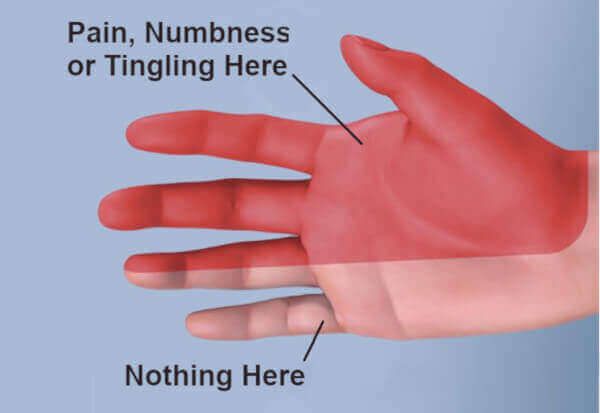Hands Hurt Driving: Maybe it's Carpal Tunnel
Table of Contents
- If your hands hurt driving, it’s probably carpal tunnel
- Why hand pain, driving & carpal tunnel go together
- Gripping the steering wheel
- Mechanical vibration
- Summary
Do your fingers or hands hurt driving your car? Perhaps they go
numb or tingle. It's a sign you could have
carpal tunnel syndrome. In fact, getting these symptoms while holding a steering wheel is usually when most people first become aware they have this serious condition.
The
National Institutes of Health (NIH) says you must pay attention to feelings like pain, numbness or tingling in hands and fingers
specifically
while driving. The steady gripping of the steering wheel combined with the car's vibration usually produces the
first signs of carpal tunnel syndrome. Here's what's happening to your fingers and hands.
If your hands hurt driving, it’s
probably
carpal tunnel
Carpal tunnel syndrome is one of the most common medical disorders seen by doctors. And it
the most common
disorder of the hand. What's most alarming is the incidence of
carpal tunnel syndrome is increasing dramatically every year.
Most people with early or
mild stage carpal tunnel syndrome are not even aware they have it. That's why the first sign many people get that the condition has started is when their hands hurt while driving a car.
People often just pass it off and say they have “tired hands" without understanding how serious it might be a year from now. So if you have finger or hand
pain,
numbness, tingling (pins & needles),
shooting electric shocks,
weakness or clumsiness, be smart and pay attention. If the same thing happens when holding a phone, coffee cup, frying pan, or any time you grip something tightly, you should get help now.
Note that carpal tunnel syndrome can first appear as any one or all of those symptoms in the hand or fingers. Pain can manifest as different kinds of sensations, running the whole spectrum of discomfort. These include feelings like sharp or stabbing pain, stinging, burning or grinding pain. In others it might feel like aching, throbbing or a dull pain.
The sensation of pain is different from person to person. It can even change over a few weeks from one sensation of pain to another.
Pain is usually
felt along with numbness or tingling. It's also often accompanied by hand weakness. In more
severe carpal tunnel cases, patients begin
losing grip strength and dexterity. That makes it hard to make a fist, create a pinching action, or pick up small objects like coins or keys.
Therefore, if your hands hurt while driving, you've probably lost some grip strength, too.
Why hand pain, driving & carpal tunnel go together
The NIH is very clear that the relationship between having your hands hurt, driving & carpal tunnel is rising dramatically. In other words, the cases of carpal tunnel syndrome are increasing in
frequency.
The reason for this problem showing up while driving is two-fold:
- Maintaining a grip on the steering wheel, and
- Mechanical vibration from the car
These two reasons for acquiring carpal tunnel syndrome are also seen in certain industries. For instance, workers who use
power hand tool use (vibrating tools) are prone to getting carpal tunnel syndrome. So are people who spend hours gripping other types of vibrating equipment (construction workers,
hair stylists, motorcycle riders, floor polishers, etc.).
Gripping the steering wheel
Driving your car requires you to grip the steering wheel. As a general rule, gripping requires your fingers to curl. That means your
flexor tendons are pulling your finger bones tightly. In fact, they do so with surprisingly great force.
Any such gripping strains the flexor tendons. And if you're already
prone to carpal tunnel syndrome (or have it) those tendons are on the verge of failing. Gripping a steering wheel merely pushes the tendons over the brink.
That’s why feeling unpleasant symptoms while gripping a steering wheel is when many people first notice they have a problem in their hands.
Mechanical vibration
In addition to gripping the steering wheel, there’s another problem that driving causes. Most cars transmit small, high speed vibrations from the road and engine. It travels up and into the steering wheel and into your hands.
It's very well documented that vibration contributes to causing carpal tunnel syndrome. In fact, a related condition called
vibration syndrome can happen with excessive hand vibration.
So combining the gripping action
plus
the steering wheel vibration creates a perfect storm for making your hands hurt:
driving & carpal tunnel syndrome are definitely related!
Note: Vibration damage is the reason doctors advise patients to NOT use a vibration massager to relieve symptoms of carpal tunnel syndrome.
Summary
It’s most likely the reason your hands hurt driving is due to carpal tunnel syndrome, primarily due to it's high incidence rate. And it’s also likely you had this disorder lurking the background for a long time without noticing it. But now it has probably advanced. Gripping the steering wheel combined with automotive vibration is the reason you're feeling the problem now. The gripping and vibration has caused your already damaged and inflamed tendons to get even worse. And as they worsen, symptoms come to the forefront. This is the time to do something about it before symptoms become even more severe.
About





